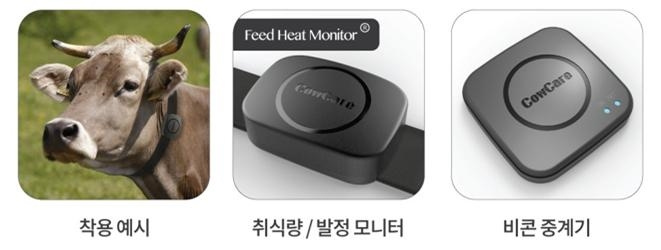Real-time feed-heart monitoring commercialized by JNU
· Writer : Jeju National University ·Date : 2021-12-30 00:00:00 ·View : 34
-
noImage
제주대-(주)HRG, 세계 최초 사료섭취량 심박수 실시간 모니터링 상용화
Real-time feed-heart monitoring commercialized by JNU

System for Early Diagnosis of Dairy and Beef Cattle Diseases
Jeju National University’s Research Institute for Veterinary Science (Director Yoon, Young-min) announced that the institute and HRG Co., Ltd. jointly developed a wearable device that enables the measurement of heartbeat rate and amount of rumination for cows for the first time in the world.
The system now allows for an early diagnosis of diseases in dairy and beef cattle.
The novel system collects bio-clinical signals from cows using Internet of Things (IoT) sensors and transmit them to servers. The server then refines the collected data, including heartbeat rate, respiration rate, amount of feed taken, rumination, estrum, metabolism, claudication, and weight gains.
In comparison of eight major features with those of competing products, SCR Dairy Heat time merely provides rumination, estrum, and early detection of atlantoepistrophic subluxation. Most competing products have limited functions, which are estrum and rumination. However, the present development is expected to provide all the items of diagnosis, including heartbeat rate, respirations, feed, rumination, estrum, claudication, weight gain, and early detection of subluxation (please refer to the table).
The aim of the system is to improve economic gains of owners by establishing an artificial intelligence-based (AI-based) server having the refined data.
The development was a part of the 1st Generation Smart Farm Commercialization Technology Development Plan organized by Korea Institute of Planning and Evaluation for Technology in Food, Agriculture, and Forestry, supported by the Ministry of Food, Agriculture, and Forestry (from Oct. 2020 to Nov. 2021).
JNU plans to sell the ‘wearable devices for cows’ and ‘PC-based AI-engine applications for vets and owners’ across Jeju through networks of veterinary hospitals.
Also, models will be diversified, by types of livestock and by functions, so that reasonable price plans can be provided to lower economic burden.












 예비대학생
예비대학생 재학생
재학생 졸업생
졸업생 일반인
일반인 교직원
교직원